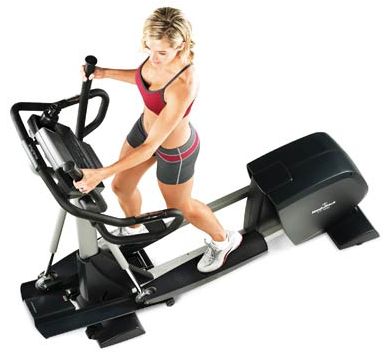Get Started With High Intensity Interval Training
Adding some high intensity interval training routines to you exercise regimen is an excellent way to boost your cardiovascular performance and improve your endurance. There are also many other side benefits to interval training, such as burning fat, but we will get into that in a bit. We will also go over some typical interval training examples.
High intensity interval training, or ‘HIIT’, is not nearly as complicated as it sounds. The basic premise is to perform a series of exercises where you alternate between periods of high intensity and low intensity. So what are some interval training examples? Well, ideally, you want to perform some type of activity where you can easily increase the intensity of your workout and then slow it down. A good example of this would be doing a full out sprint, followed by a slow jog and repeating this a set number of times. Of course, running isn’t the only form of HIIT that you can do. It can be applied to almost any form any exercise, from swimming to cycling to elliptical machines.
They key to the training is the interval, an interval being a cycle of exercises that you repeat a fixed amount of times. But what is the best way to structure the exercises? For HIIT, you want to perform an activity that can get your heart rate up somewhere between 75-85% of your max heart rate, followed by a period of low intensity activity, and you want to repeat this cycle anywhere from 4 to 12 times (depending on your current level of fitness), that complete cycle is considered the ‘interval’. (Calculate your max heart rate by subtracting your age from 220.)
How long should these cycles last? Well that again depends on your current fitness level. If you are just starting out, try doing 10 seconds of intense work, followed by 20 seconds of rest. This would be known as the work/rest ratio and in this example it is ½ (10 seconds divided by 20 seconds). You can vary this ratio anyway you like, while the higher the number the harder the workout will be. You might like to do 30 seconds of work followed by 30 seconds of rest (ratio of 1). The key thing is to just repeat this for set amount of cycles.
Lets assume for a second that you don’t have a way of monitoring your exact heart rate. That is, you don’t have a heart rate monitor or aren’t using a machine that tells you your heart rate. Luckily, that’s really not an issue. Although not as precise, you can simply exert yourself to what you feel is about 80% of your maximum effort. For example, you probably know what it feels like to sprint as fast as you possibly can, so then simply sprint at about 80% of that maximum effort. This may take you a little practice, but with a little trial and error you can get a good feel for hitting the proper peak of your interval.
This is actually our preferred way of doing our high intensity interval training routines. It makes it a lot less complicated and a bit easier because you aren’t constantly calculating and monitoring a number.
It simply boils down to this: perform the given activity with everything you’ve got and follow it with a rest period. It is important to remember when you are on the resting part to make sure you are still doing an activity. In other words, don’t just stop and sit down. You want to keep the heart pumping. So if you are swimming, just swim really slowly, or if you are jogging, just jog at a slow pace.
Depending on how you choose to structure your interval, you can see it really won’t take very long to complete (roughly 10-25 mins depending on your method), but since you are working your body so hard, you’ll get a lot of benefit in just a short period of time. In fact, studies show that you can drastically improve cardiovascular fitness and endurance in just a few short weeks by incorporating high intensity interval training routines.
Also, with interval training it is important to make sure you warm up as well as cool down. So do a light warm up for 5-7 minutes. This will get the blood flowing and muscles warmed up. Then, after performing your interval, cool down for at least another 5 minutes, with a walk or some other form of very light exercise.
High Intensity Interval Training Routines
So then, lets layout a few routines you could try out for yourself. We’ll provide 2 different types of interval training examples: one for running and one using an elliptical. You can really adapt these to any exercises your prefer, the important thing is to focus on the timing while exerting the appropriate amount of effort.
Sprinting:
- Start with 5-7 minutes of moderate paced walking
- Run almost as fast as you can for 10 seconds
- Walk for 20 seconds
- Repeat steps 2 and 3 six to eight times
- Walk for 5 minutes
Elliptical:
- Use the elliptical on a low setting for 7 minutes
- Crank it up to high (whatever setting is high enough for you to be well out of breath after 30 seconds) and do that for 30 seconds
- Do the low setting for 30 – 45 seconds
- Repeat steps 2 and 3 for to 10 times (depending on your ability)
- Cool down using the low setting for 5-10 minutes
That’s really all there is. Just follow these guidelines and adapt a routine that works for you. Interval training is taxing on your body, so try to limit it to no more than a couple times a week. Its also a good practice to use different work/rest periods each time as well. For example, some days try the high intensity for 1 full minute, followed up by 2 minutes of rest, but then repeat just 3 to 4 times.
As we mentioned before, there are a number of other benefits of high intensity interval training besides improving cardio function and endurance. They include increased lactate threshold. This is your body’s ability to handle lactic acid buildup. The higher the threshold, the less you tend to experience muscle ‘soreness’. Also, because you are performing high intensity activities, you are maximizing fat burning.
There is also an effect known as the afterburn effect, referred to as EPOC, or excess-post oxygen consumption. What this means is that your body experiences increased metabolism and burns more calories post exercise for up to 24 hours after your interval training. This does not happen with normal exercising alone, such as simply going for a run or swim.
Finally, there is an anabolic effect to HIIT. Studies show that it can actually aid in helping your body build muscle. This is why you often see a lot more muscle mass in sprinters as opposed to long distance runners, who are generally skinny by comparison.
There you have it. There are a lot of benefits to performing high intensity interval training. It is an extremely effective (and fun) way of getting in shape. Perhaps best of all, you really don’t need any exercise equipment to be able to do HIIT. You can just put on a pair of running shoes and go outside and get started right away!







0 Comments
You can be the first one to leave a comment.